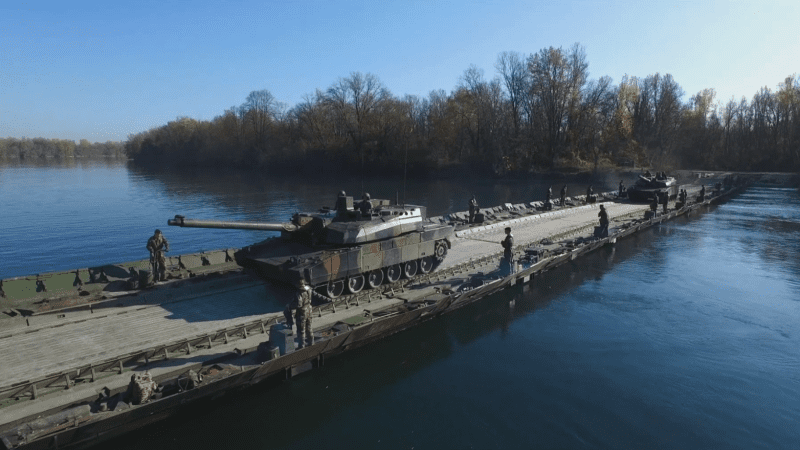Providing effective support to forces in operation

A French CNIM Systèmes Industriels company (Constructions Industrielles de la Méditerranée), created in 1856, has been operating in many modern technology sector, such as nuclear, space and defence industries. CNIM Systèmes Industriels was chosen to deliver new ponton bridge sets for the Polish Armed Forces, within the Daglezja-P project. The bridge sets would allow the Polish M1A2 Abrams SEPv3 MBTs to cross the rivers.
As a major partner in the defense and security industry, CNIM Systèmes Industriels has been supporting armed forces since 1856. CNIM Systèmes Industriels provides support to armed forces in their missions and offers a range of reliable equipment and solutions, fully tested and at the leading edge of technology.
Since 1980s, the French manufacturer has been delivering pontoon bridges for the French Armed Forces. We can also mention the wheeled assault bridge SPRAT (Système de Pose RApide de Travure), that was created in 2003.
In 1981, CNIM Systèmes Industriels was ordered by the French Ministry of Defence to develop the PFM Motorized Floating/Pontoon Bridge. Currently, in response to new requirements of the various NATO countries, and to meet the current and future battlefield requirements, the French manufacturer has developed a new version, PFM New Generation.

Designed for ferrying the heaviest of vehicles both now and in the future, the PFM has, MLC 90 Tracked and MLC 100 Wheeled crossing capability, in accordance with the STANAG 2021 norm. This ensures a safe crossing for all combat and logistic vehicles, such as the heaviest Main Battle Tanks including Abrams M1A2 SEPV3, Leopard 2A7 and Challenger 2, as well as tank transporters.
Two module/pontoon lengths (6.75 m and 11 m), are being offered. They can be transported either on 8x8 carriers with self-loading systems for palleted payload (PLS) – PFM XP or be deployed from special semi-low loaders – PFM LG.
Unrivalled ease of construction and speed of deployment of the crossing
Featuring integrated engines, the PFM modules can be controlled from a single remote control & command system, allowing for quick & easy construction and deployment and reducing the logistical footprint (no need for auxiliary craft/cutters) and number of operators. On the other hand, a 100-meter bridge requires a crew of 38. Its deployment time is 30 minutes, and it can carry up to 250 vehicles per hour.
With the ability to take two different access ramps: multi-purpose tactical ramps or modular tactical ramps, the PFM motorized floating bridge can be adapted to various operational doctrines. It is also interoperable with all floating bridges in service.
PFM is conceived from the start for airborne transport, which enables a quick deployment of the motorized floating bridges, even at long ranges (strategic transport) in a relatively short time.

Reduced logistical footprint
The New Generation Motorized Floating Bridge therefore ensures quick and easy deployment, provides excellent manoeuvrability and enhanced performance on water, while considerably reducing the logistical and personnel footprint (no tug boats, remote control & command system, optimised number of carriers).
As the PFM can be deployed as bridge or ferry, it is a very flexible solution. It is available in multiple configurations in order to meet individual client requirements.
Let us remind that the framework agreement signed with the CNIM Systèmes Industriels is concerning the deliveries of PFM motorized floating bridges for the Polish Engineering Forces. The contract assumes that the Armament Agency would procure pontoon bridge packages by the end of 2026, at a price of up to PLN 1.5 bn. (approx EUR 320 million), whereas a single example would come at a gross price of PLN 115 million. The contract also includes a training package, documentation, granting of a license, delivery of spares, and consumables, along with repair kits.
In practical terms, the above means that there is an option to procure up to 13 sets within the said budget, that would replace the obsolete PP-64 Wstęga bridges, dating back to the 1960s. The Wstęga bridge sets were being put into use extensively in recent years. Not only did it happen during exercises, but also involving the NATO forces, but also in the course of natural disaster response operations and during crises - also when the Czajka wastewater treatment plant in Warsaw malfunctioned in 2019 and 2020.

ROCUS (Route Clearance Unmanned System)
In current conflicts, IEDs (Improved Explosive Devices) are responsible for many human and material losses.
CNIM Systèmes Industriels has developed a route clearance system based on the THeMIS platform (MILREM Robotics') in order to meet the security needs of military convoys.

ROCUS (Route Clearance Unmanned System) is able to operate in difficult terrain, combining endurance and robustness. It can inspect, confirm and neutralise the threat to ensure the safety of soldiers and the progress of convoys.. ROCUS is an unmanned vehicle, equipped with a 4-metre long arm. It can operate for up to 10 hours. It can also be equipped with various sensors, such as georadar.
The ROCUS tracked vehicle features high mobility (maximal speed up to 20 km/h) and low ground pressure. It can intervene in all environments and follow troops in the most remote areas. Thanks to an intuitive interface and the Bird View mode, ROCUS is easy to configure and use.
An article prepared in cooperation with the CNIM Systèmes Industriels company



